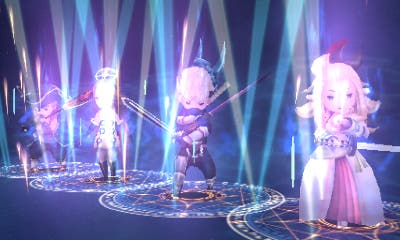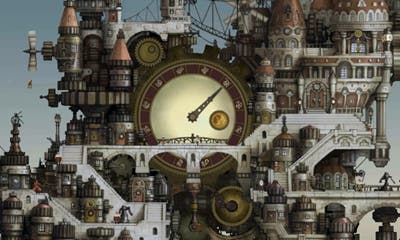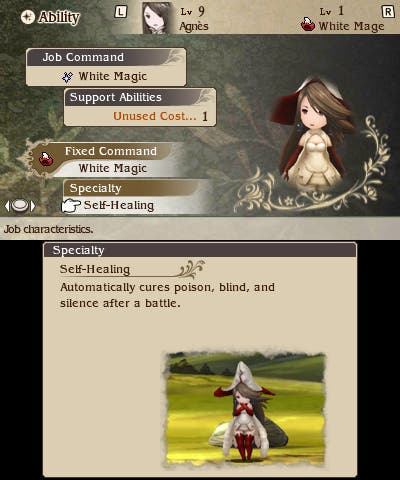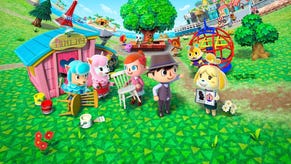Bravely Default review
Post fantasy.
Despite a reputation for creative conservatism, Japanese role-playing games have enjoyed something of a revival of the imagination in recent times. The recent triumvirate of Nintendo Wii titles, Xenoblade Chronicles, The Last Story and Pandora's Tower, demonstrated the potential for ingenuity and originality in this often staid genre - particularly Xenoblade, which is one of the most interesting games of any sort of the past decade.
Bravely Default continues the run. Despite being funded by Square Enix, which made its name and fortune with the blueprint-establishing Final Fantasy and Dragon Quest series, this is a game that frequently subverts the classic designs. Its makers pile the novelties high in a way that will delight and surprise both genre die-hards and newcomers.

A pseudo-sequel to Final Fantasy: The 4 Heroes of Light, Bravely Default benefits from its step away from the Final Fantasy brand. Removed from that hotchpotch lineage, developer Silicon Studio (best known for the adventure game 3D Dot Game Heroes) is free to explore less familiar territory and styling without needing to make constant nods towards any one tradition (although Final Fantasy's faded crystals and creaking airships feature). While character designs come from the unmistakeable pen of Akihiko Yoshida (the artist behind Final Fantasy Tactics, Vagrant Story and other classics), the exquisite watercolour backgrounds, magically rendered in the 3D, are like nothing else. They infuse the game with a strong feeling of place and scale (aided by a lingering zoom that accompanies your arrival at any new location) and a sense of aesthetic wonder.
The story is less unusual, although it's unafraid to poke fun at itself (one character is nicknamed 'Mr Amnesia', a dig at JRPGs' over-reliance on that particular plot device). Protagonist Tiz Arrior is a 19-year-old shepherd from the village of Norende who, at the start of the game, watches as his village is swallowed up into a great chasm. He manages to escape the gobbling rift and soon makes the acquaintance of Agnes Oblige, a mage girl with a terrible sense of direction who is being pursued by the nefarious Eternian Sky Knights. The pair jostle their way across the kingdom, battling Eternian officers who hold the keys to some of the game's most interesting mechanics, on a quest to find out what has knocked the world's tectonic plates out of joint.

The game's awkward title derives from its central - and brilliant - conceit. Battles have a traditional turn-based structure: one by one, you choose to attack or defend against foes, and then you sit back as the computer takes its moves in turn. Buts as well as performing straightforward attacks, your characters are able to select two further types of move: 'Brave' and 'Default'.
The former allows a character to take up to four turns in sequence, all at once. The cost of this wager is that, if you fail to defeat your opponent during the flurry of attacks, the character must then wait patiently while the enemy takes an equal number of retaliatory turns. 'Default', by contrast, is a safer bet. Here your character will defend themselves and store up a free extra turn in the process. 'Default' four turns in a row, for example, and on the fifth turn you will be able to attack four times uninterrupted.
It's an ingenious system that introduces a complicated risk/ reward dynamic to fights. As individual characters in your party can Brave or Default at any time, you can have certain characters launching full offensives while others hold back, spreading your strategy out across multiple turns of play.

Further complexity is added to the meta-game, which draws upon Final Fantasy 5's hugely influential 'job' system. When you defeat an enemy officer (Bravely Default's version of boss fights) you learn a new class, which can be taken up by any of your characters. These jobs (there are 24 to collect across the game) affect the moves a character can use, as well as their statistical strengths and weaknesses. They range from the usual Dungeons & Dragons options such as Monk, Mage, Knight and Thief to more exotic varieties like Pirate and Vampire. As a character earns experience points in a job, they unlock new moves and abilities, and you can carry unlocked moves across into different classes, thereby building a team of four characters that is unique to your own tastes, focus or strategy.
As well as some exquisite stereoscopic 3D, Bravely Default makes creative use of the 3DS' other features. You can collect custom attack moves from nearby players via StreetPass and, if you put the 3DS into sleep mode while the game is on, you'll accrue Sleep Points (one for every eight hours of standby) which can be used to freeze time during a battle, allowing you to attack freely for a single turn. There is some light monetisation here as you can buy SP 'drinks' from Square-Enix, but with a flexible difficulty option, there's little need for this crutch.
The core conceit adds new capacity for strategy; it's a genuine and interesting invention

Over the course of the game you must also work to rebuild Tiz's home village Norende - a side-quest based on mobile phone village-building games (and, mercifully, not monetised). Builders and workers must be collected via StreetPass. With each new StreetPass hit, Norende gains a new resident. Ingeniously, the number of residents you collect has a direct bearing on the speed at which you may repair the town; a task that takes one worker an hour to complete only takes two workers 30 minutes. Collect 10 residents and the job is done in six minutes, and so on. Land must be tilled to prepare it for building work and, once readied, you can touch a site, set the worker count and begin building the required shop. In this way Norende's repair mirrors your character's journey, from having lost his family, friends and livelihood at the start of the game, to rebuilding his life and community over the course of the story.
Bravely Default's ideas are, arguably, mostly novelties adorning what remains a traditional game at heart. Certainly the interplay of combat and fiction is familiar - potently so. But the core conceit adds new capacity for strategy; it's a genuine and interesting invention. And despite the now completely lifeless use of mystical crystals as a plot device, as the game progresses, scriptwriter Nataka Hayashi begins to subvert the clichés in unexpected ways. What's easy to dismiss as by-the-numbers plotting will delight and surprise you in time.
Brave, then, for Square Enix to drop the Final Fantasy moniker in favour of a curious title with no cachet. But it's apropos: beneath the well-known veneer, Bravely Default is, to a certain point, something else entirely.






